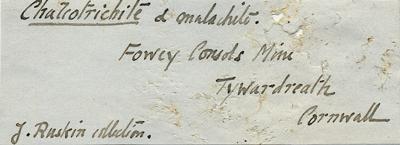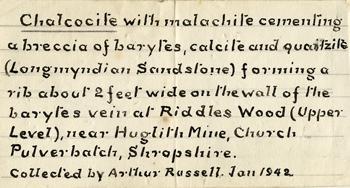Russell, Sir Arthur (1878-1964 )
Arthur Edward Ian Montegu Russell, the doyen of 20th-century British mineral collectors, was born on November 30, 1878 in Swallowfield Park, Reading, Berkshire, the son of Lady Constance Charlotte Elizabeth Lennox and Sir George Russell, 4th Baronet. It was from his mother that Arthur first acquired his intense interest in mineral collecting. As a girl Lady Constance had received elementary instruction in mineralogy from "Miss Henson," sister of the London mineral dealer Samuel Henson, and had purchased specimens. She also visited the British Museum to study their minerals. Her considerable collection, which she gave to Arthur when he was just seven years old, was the nucleus of Arthur's, own great collection which was destined to become the finest and most comprehensive private collection of British minerals ever been made.When he was eight years old Arthur made his first visit underground to a working mine, the Wheal Providence at Lelant near St. Ives, Cornwall (and was very frightened descending the latters). Three years later he went underground at the Botallack mine, St. Just, Cornwall, and thereafter he visited and collected at nearly every mine in Great Britain and Ireland, and went underground in nearly every metalliferous mine in the British Isles that was operated during his lifetime. He devoted much attention to both working and abandoned mines, and often spent whole days and nights underground collecting specimens.
Arthur was educated at Eton and studied chemistry at Kings College, London. Upon the death of his father in 1898 he left school and took an appointment with the London and South Western Railway. This continued the family connection with railways, and in later years the name plate from the engine Swallowfield Park was kept close to his mineral collection. He served in France during World War I and was invalided home in 1915. He then joined the Royal Engineers as a Lieutenant, but was later transferred to work on British mineral resources; for example, he investigated the chromite deposits of the Shetlands. He was awarded an M.B.E. ("Member of the British Empire") in 1920. During the following years he visited ore deposits in Europe, especially in Spain and Portugal, and continued to collect specimens at important localities such as Panasqueira. Arthur succeeded to his father's title as 6th Baronet upon the death of his older brother in 1944.
Russell had a great sense of humor and could get along well with nearly everyone he met; his skill at making friends among mine and quarry managers, miners and quarrymen served him well in facilitating acquisitions. He was usually notified by these friends of any interesting discoveries being made in mines or quarries, and consequently was able to save many fine specimens which might otherwise have been destroyed.
Russell had a keen eye for good specimens, especially for the rarer and more unusual species which others often tended to overlooked. He made careful notes on mineralogical conditions and seemed to have an instinctive feeling for where minerals might be found. Over the years he absorbed a substantial number of collections into his own, some dating back to 1800 or earlier, and many containing specimens that could no longer be found at the localities. Among the more important were the collections of Philip Rashleigh (1728-1811), Lady Elizabeth Coxe Hippisley (1760-1843), John Hawkins (1761-1841), John Hamrease (1764-1811), George Croker Fox (1784-1850), Edmund Pearse (1788-1856), Robert Were Fox (1789-1877), Isaac Walker (1790-1853), Alfred Fox (1794-1874), Sir Maziere Brady (1796-1871), Baroness Burdett-Coutts (1814-1906), Sir Warington W. Smyth (1817-1890), John Ruskin (1819-1900), Col. R.B. Rimington (1828-1910), Arthur Champernowne (1839-1887), J.H. Collins (1841-1916), W. Semmons (1841-1915) and Samuel Henson (1848-1930).
The Russell Collection at Swallowfield Park became famous throuhout the world, and was visited by many enthusiastic mineralogists and collectors from across Europe and America. It contains many outstanding specimens, but special mention must be made of the excellent suites of chalcopyrite, chalcocite, fluorite, barite, pyromorphite and mimetite, and his extensive suites of Irish minerals. Russell didn't use pre-printed mineral labels, but instead made carefully hand-lettered labels in a distinctive style.
He served as President of the [British] Mineralogical Society from 1939 to 1942; received the Bolitho Medal from Royal Geological Society of Cornwall in 1948; received the Henwood Medal from the Royal Institution of Cornwall in 1953; and was awarded an honoray Doctor of Science degree from the University of Oxford in 1956. He published more than 30 descriptive papers on mineralogy, most of them in Mineralogical Magazine. He described and named the new species rashleighite, and was horored by the naming of the minerals russellite and arthurite.
On his death on February 23, 1964, at the age of 86, he bequeathed his superb collection (about 12,000 specimens) to the British Museum (Natural History), together with storage cabinets, maps, notes and many books, on condition that it would not be sold but would be kept in perpetuity as a British regional collection.
Click to images to view larger
To contribute more information please E-mail us at:
minrecord@comcast.net
Citation format for this entry:
WILSON, Wendell E. 2022
Mineralogical Record
Biographical Archive, at www.mineralogicalrecord.com
minrecord@comcast.net
Citation format for this entry:
WILSON, Wendell E. 2022
Mineralogical Record
Biographical Archive, at www.mineralogicalrecord.com






